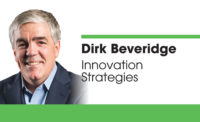Last month we talked about two criteria to help your company break the sameness trap (being bold and being deep). Here are the final two pieces of the puzzle to help your company take that next important innovation step and set itself up for success now and into the future.
Disrupt your company
Think about organizations and industries that have been disrupted. Some of the most-disrupted in recent history have been newspapers, music, books and now most recently taxis.
The Graham family, which owned The Washington Post since 1933, came to the conclusion it didn’t know how to keep its newspaper business relevant and profitable in today’s market. After generations of Graham ownership and control, it asked good friend Jeff Bezos of Amazon fame if he was interested in buying one of the oldest, most iconic newspapers in the nation. Bezos never did any due diligence nor did he fly to Washington with a team of lawyers and accountants. Instead, he asked the Graham family what it thought the company was worth. They said $250 million and he wrote them a check.
Bezos wasn’t interested in the due diligence because he recognized an opportunity to save a disrupted industry. He decided to conduct an experiment to see if he could save the newspaper industry.
The day the sale closed, Bezos couldn’t be in Washington to meet his new employees because he was stuck in Seattle. Instead, he sent a memo, which also was published in the Washington Post. It explained to the employees, “There will, of course, be change. We will need to invent, which means we will need to experiment. Our touchstone will be our readers (in essence, their customers), understanding what they care about and working backwards from there.”
Here is one of the most brilliant leaders and innovators of our time saying the touchstone of being disruptive is to understand your customers better than anybody else! He’s saying if you want to be disruptive, begin by getting closer to your customers.
Understanding your customers’ needs and wants, sometimes before the customers know their needs and wants themselves, is the sign of a disrupter, an innovator.
If you want to get closer to your customers than anybody else, there are three frameworks you need to think about and innovate into your company:
- You must think about the gains your customers are trying to achieve.
- You must think about the pains they’re trying to eliminate.
- You must think about the jobs your customers will pay to have done.
As Joe Nettemeyer, CEO of technical solutions provider Valin, puts it, “We have to identify where the customer is having its struggles and we have to help them overcome the struggle. That’s pretty important to the value. It’s not easy and it requires thinking. It requires you start developing that value proposition now, not five hours before you have to do something.”
To get deep to the point of disruption in your company, look at A.G. Lafely and what he’s done at P&G as well as what he wrote about in the book The Game Changer. He shares how P&G worked hard to deeply understand its customers, explaining, “We had to get out of our offices and become immersed in the real world and the daily routines of our consumers and in the stores of the retailers we partner with.”
You have to get out of your offices and your business. You have to get into the business of your customers. At P&G, they call the process, “Working It.” They have employees work behind the counter of a small shop to gain insights into why shoppers buy (or don’t buy) a product. They see how the shopkeeper stacks the shelves and learn what kind of value propositions are going to be appealing to them.
When is the last time you spent an entire day in the field or in the territory shadowing one of your customers? Not to sell them anything, but to understand their struggle.
Only when you have that insight into your customer base and what their needs are can you do brainstorming sessions to start figuring out what you can do to break the sameness trap, break through commoditization and set yourself apart from your competitors. You must be disruptive by getting deeper than ever with your customers.
Be good
If we hope to break the sameness trap, we too have to migrate to a higher level value proposition. This means we must be good.
Most businesses are trapped in the world of sameness because the only thing they’re focused on is profit. Conscious capitalism says there’s more to business than profits. It says there is the triple bottom line; profit, people and the planet. If we’re going to break the sameness trap, the school of thought of being good says we must think in terms of the triple bottom line with those three Ps of conscious capitalism.
One of the things we talk about in distribution is the labor shortage and the inability to attract good talent. If you want to attract good talent and bring more millennials into your organization, you’re going to need to focus on doing good. Studies have shown millennials are attracted to organizations that are doing good beyond dollars.
It doesn’t stop there, either. American Express will tell you, from its own studies, the rise of conscious capitalism is truly good for doing business. The Harvard Business Review has performed studies that find companies that practice being good generally perform 10 times better than similar companies.
Stomp out sameness
Not only is it possible to break the sameness trap within your own organization, it’s completely within your grasp if you’re willing to make a concerted effort.
Think about sitting down with that customer or prospect who asks, “What makes you different? What makes your company special?” and having an actual answer to give them.
Too many distributors are stuck in a world of sameness. Break the sameness trap and stand apart from your competitors by being bold, being deep, being disruptive and being good.
I leave you with a few more words from Valin’s Nettemeyer, “We have things occurring right now that are shaping the future. In this environment, innovation and separating yourself from the competition has become an imperative.”




